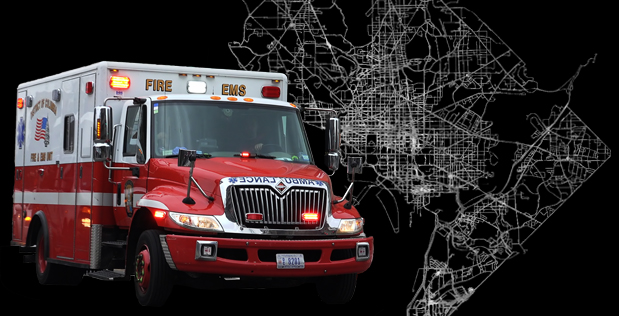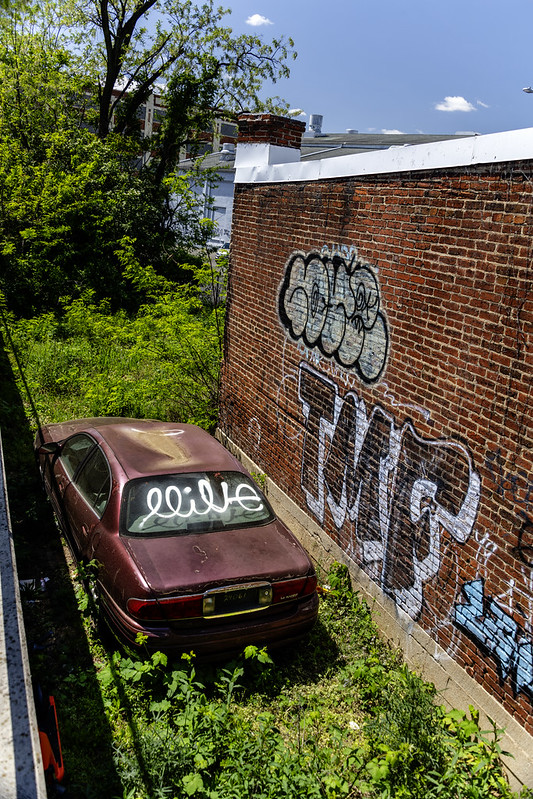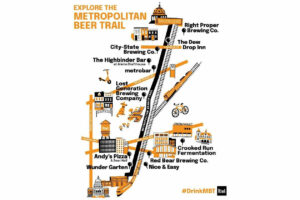
“For approximately seven months starting in July 2016, the fleet of D.C. Fire and Emergency Medical Services ambulances was outfitted with DARPA-developed nuclear and radiological detectors, providing the first city-scale, dynamic, real-time map of background radiation levels throughout the Capital as well as identifying any unusual spikes that could indicate a threat.”
I know this is supposed to make us feel safer but, uh, gulp.
From DARPA (Defense Advanced Research Projects Agency):
“DARPA’s SIGMA program—whose goal is to prevent attacks involving radiological “dirty bombs” and other nuclear threats—concluded its biggest and longest test deployment of vehicle-mounted radiation detectors in Washington, D.C., in February. For approximately seven months starting in July 2016, the fleet of D.C. Fire and Emergency Medical Services ambulances was outfitted with DARPA-developed nuclear and radiological detectors, providing the first city-scale, dynamic, real-time map of background radiation levels throughout the Capital as well as identifying any unusual spikes that could indicate a threat.
Because medical and fire emergencies occur in every corner of the District every day, emergency vehicles equipped with radiation detectors provide an excellent means of achieving a large-scale scan for radiological risks. In the just-completed test deployment, up to 73 large detectors were installed on emergency vehicles that together logged well over 100,000 hours of detector operation covering more than 150,000 miles, and identified in real-time thousands of radiation sources. Items as innocuous as natural granite used in construction, as well as lingering radiation after certain medical treatments, can trigger positive responses. SIGMA detectors can readily distinguish between these kinds of benign sources and threatening ones. Equally important, the SIGMA detectors provided detailed background radiation maps of the District against which future sources may be more easily detected. The deployment also offered an opportunity to test and refine the wireless data fusion aspects of the system, which constantly fed information about vehicle location and radiation readings to a central command post.
“D.C. Fire and EMS was an invaluable partner and testbed for SIGMA’s vehicle-scale detectors,” said Vincent Tang, DARPA program manager. “The data gathered during the D.C. deployment are helping to further fine-tune the SIGMA system for potential deployment in major cities across the country and for emergency use by active-duty military units and National Guard civil support teams.” While ambulances were used in the D.C. test, the program envisions the possibility of using other options for getting distributed coverage in future deployments in other cities.
“Historically, increases to detection capabilities came from improved individual detectors,” said John Donnelly, D.C. Fire and EMS deputy fire chief. “The most significant capability gain since 9/11 was spectroscopic detectors for first responders. D.C. Fire and EMS was interested in the SIGMA program because DARPA approached the problem differently. By not only putting more spectrometers into the field but also networking them so that the data is continuously collected and analyzed with other, and prior, information as a whole, SIGMA laid the groundwork for a monitoring system that can incorporate intelligence holistically into risk assessment. Incorporating more data will further improve the ability of the SIGMA system to differentiate between ‘safe’ and illicit radiation sources, and increase our capabilities to monitor wide-areas for radiological and nuclear threats.”
DARPA’s SIGMA system has developed two types of radiation detectors—a larger size like those recently deployed in the emergency vehicle tests and inexpensive, smartphone-sized mobile devices that can be worn on a belt by police officers or others. The devices run on advanced software that can detect the tiniest traces of radioactive materials. Those devices, networked with detectors along major roadways, bridges, and other fixed infrastructure, promise significantly enhanced awareness of radiation sources and greater advance warning of possible threats. The SIGMA detectors themselves do not emit radiation but detect gamma and neutron radiation emanating from sources.
In October 2016, DARPA oversaw a successful one-day test deployment of more than 1,000 smartphone-sized mobile SIGMA detectors, during which volunteers walked for several hours in the vicinity of the National Mall with the small detectors tucked inside backpacks. Other tests in the past year in the Washington, D.C., metropolitan area and other locations have also demonstrated the networked system’s efficacy.
DARPA plans to further test SIGMA’s wide-area monitoring capability and transition the operational system to local, state, and federal entities in 2017 and 2018.”
Recent Stories

Photo by Tim Brown Ed. Note: If this was you, please email [email protected] so I can put you in touch with OP. “Dear PoPville, Thursday night (April 18th) we were…

For many remote workers, a messy home is distracting.
You’re getting pulled into meetings, and your unread emails keep ticking up. But you can’t focus because pet hair tumbleweeds keep floating across the floor, your desk has a fine layer of dust and you keep your video off in meetings so no one sees the chaos behind you.
It’s no secret a dirty home is distracting and even adds stress to your life. And who has the energy to clean after work? That’s why it’s smart to enlist the help of professionals, like Well-Paid Maids.

Unlock Peace of Mind for Your Family! Join our FREE Estate Planning Webinar for Parents.
🗓️ Date: April 25, 2024
🕗 Time: 8:00 p.m.
Metropolitan Beer Trail Passport
The Metropolitan Beer Trail free passport links 11 of Washington, DC’s most popular local craft breweries and bars. Starting on April 27 – December 31, 2024, Metropolitan Beer Trail passport holders will earn 100 points when checking in at the
DC Day of Archaeology Festival
The annual DC Day of Archaeology Festival gathers archaeologists from Washington, DC, Maryland, and Virginia together to talk about our local history and heritage. Talk to archaeologists in person and learn more about archaeological science and the past of our






